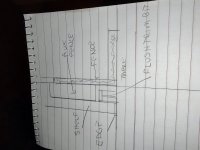ReneS
Member
I put some pine edge banding on a couple of 1/2 inch plywood shelves. I left around 3/16 of the banding on either side of the edge.
I thought I could run the shelves against a flush trim bit in my router table and quickly get the banding flush with the shelf.
But it took off only very small amounts with each pass. I ended up using a block plane to get things close, which was much quicker, and then sanded the banding flush with my ETS something something.
It is a Freud flush trim bit. I lined the bearing up with the fence of the router table. I applied pressure against the shelf into the fence and downward.
Does anyone have any ideas of what I am doing wrong?
I thought I could run the shelves against a flush trim bit in my router table and quickly get the banding flush with the shelf.
But it took off only very small amounts with each pass. I ended up using a block plane to get things close, which was much quicker, and then sanded the banding flush with my ETS something something.
It is a Freud flush trim bit. I lined the bearing up with the fence of the router table. I applied pressure against the shelf into the fence and downward.
Does anyone have any ideas of what I am doing wrong?

